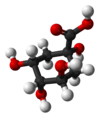Quinic acid
|
|
|||
| Names | |||
|---|---|---|---|
|
IUPAC name
(1S,3R,4S,5R)-1,3,4,5-tetrahydroxycyclohexanecarboxylic acid
|
|||
| Identifiers | |||
|
77-95-2 |
|||
| 3D model (Jmol) | Interactive image | ||
| ChEBI |
CHEBI:17521 |
||
| ChEMBL |
ChEMBL465398 |
||
| ChemSpider |
10246715 |
||
| ECHA InfoCard | 100.000.976 | ||
| PubChem | 6508 | ||
| UNII |
058C04BGYI |
||
|
|||
|
|||
| Properties | |||
| C7H12O6 | |||
| Molar mass | 192.17 g/mol | ||
| Density | 1.35 g/cm3 | ||
| Melting point | 168 °C (334 °F; 441 K) | ||
| Hazards | |||
| NFPA 704 | |||
|
Except where otherwise noted, data are given for materials in their standard state (at 25 °C [77 °F], 100 kPa).
|
|||
|
|
|||
| Infobox references | |||
Quinic acid is a cyclitol, a cyclic polyol, and a cyclohexanecarboxylic acid. It is a crystalline acid obtained from cinchona bark, coffee beans, and other plant products and made synthetically by hydrolysis of chlorogenic acid. Quinic acid is also implicated in the perceived acidity of coffee. It is a constituent of the tara tannins.
This substance was isolated for the first time in 1806 by French pharmacist Nicolas Vauquelin and further reactions from this acid to synthesize other compounds were studied by German chemist Eduard Lautemann in 1863.
It is soluble in water and crystallizes in large colorless prisms.
Quinic acid is used as an astringent. It can be found in the bark of Eucalyptus globulus.
This acid is a versatile chiral starting material for the synthesis of new pharmaceuticals. A medication for the treatment of influenza A and B strains called Tamiflu has been successfully developed and launched into the market.
Quinic acid is also thought to displace binding of the mu opioid receptor antagonist Naltrexone, even though this acid was originally thought to be pharmacologically inactive.
...
Wikipedia



